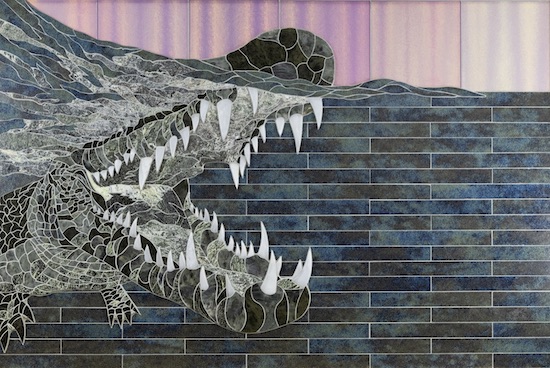Wally the Gator
There MAY be some people in the tile universe who missed the lead-in streaming programs or stories on TileLetter.com or stories in TileLetter magazine or the live stream from Wisconsin to the Coverings Lounge during the July show in Orlando concerning the 6’x4′ mosaic alligator-themed mural designed and installed by Joshua Nordstrom of Tierra Tile and Lee Callewaert of Dragonfly Tile and Stone Works. If you are one of those folks, I invite you to search TileLetter.com for the Artisans in Tile Program about the early stages of the design of this mural or the news sections of TileLetter magazine for info.
After the New Orleans skyline mosaic the duo created for the highly anticipated but ill-fated Coverings 2020, they agreed to do it again for this year’s show. “Wally the Gator” – as the piece came to be known – was inspired by the significant wildlife of the Florida landscape. Hand-cut white onyx teeth are back lit with LED lights. Other materials include Café Limestone, Tropical Granite, Green Labradorite stone, and porcelain tile. The porcelain, onyx and Labradorite were all hand milled and cut from slab material. The artisans used hand tools to fabricate the tile and stone pieces, which were then mounted and cut into the field tile for installation. The “Gator” itself is comprised of 660 pieces.
This mural was a masterpiece of collaboration, precision, design and execution. Nordstrom and Callewaert put their heads together over the miles between Alaska and Wisconsin to conceive and design this project, and then came together at Dragonfly’s Wisconsin studios in April to set the groundwork for the project, and again in July for the program that unfolded over the three days of Coverings, emceed by NTCA’s Training Director Mark Heinlein, on site in Orlando.
Assisting them were Jane Callewaert, who coordinated a lot of details and Shae Callewaert who manned the camera. Dragonfly’s craftswoman Maria Meyer and artisan Seth Ready, of Ready Set Tile & Mosaics of Broomfield, Colo., were also on hand to support and ensure the project unfolded as smoothly as possible, according to schedule.
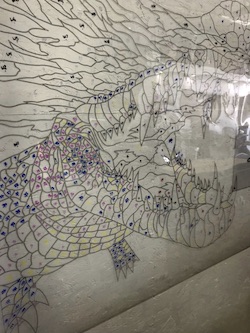

As you might imagine, there is a lot of wisdom to be gleaned from such a project. And our artisan team collaborated once again to share their top 10 takeaways from the Wally the Gator project.
1 The first task is designing and drawing so a template can be made. You are challenged to consider each piece as an individual. Each individual piece should be pleasing to the eye as well as work well with the surrounding pieces. Wally was a challenge as the initial drawing had ghost lines running through the pieces, which then needed to be removed so each piece could stand alone.
2 The team used a new method to create templates, which utilizes a vector file of our drawing. The image is then cut from an adhesive vinyl (like that which is used to wrap vehicles for signage). This vinyl method has been used with smaller projects, but Wally was the largest project to date using this method. The lesson we learned here was that it works! It saves significant time in the templating process and the pieces are very precise. While there is a cost involved, it is more than set off by the time savings.
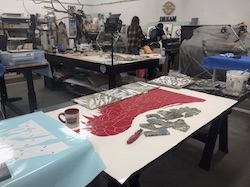

3 There are always challenges with material selections. When deciding which materials to use, color is generally a key impactor. Additionally, the texture plays a role. There were multiple materials used (glass, porcelain, onyx, limestone and granite) and they all handle differently. In the end you have to expect to do some troubleshooting and testing with a “there’s always a way” attitude. Multiple lessons learned in this regard.
4 A thin porcelain panel was selected for the water. Let’s just say there are obvious reasons why the industry offers training on gauged porcelain tile panels! From shipping, handling and cutting, there are unique challenges!
5 The Labradorite stone was found in a 3cm slab. We then sectioned and milled on the wet saw to 3/8″. This is a time-consuming process but the artisans were set on the use of this material because of its unique colors.
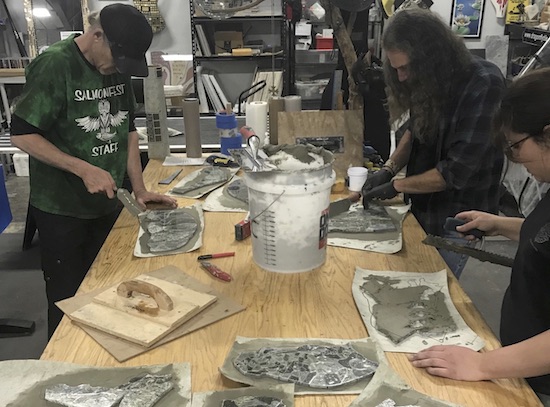

6 The Café Limestone was very soft and brittle, which was especially challenging when cutting intricate shapes. This is where the ring saw offered a great advantage. Having the tools and experience with multiple tools for fabrication is very helpful when working with so many different materials which all handle differently.
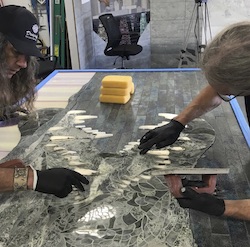

7 The glass used for the sky could not be cut from the face. We always test methods for cutting various materials, and especially this is true with glass. This particular glass had to be cut from the back. Therefore we created templates to transfer the shape onto the back.
8 Translucent onyx was selected as the ideal material for the teeth, since the design called for backlighting the teeth for a dramatic effect. It’s difficult to polish the edges of onyx, which is desired to recreate the surface sheen. It’s so soft that extra care needs to be used in handling, and we had to experiment with the best choice in polishing pads. Also, with onyx, it was important to use light thinset and a lighter colored grout so as not to stain or discolor the white onyx.
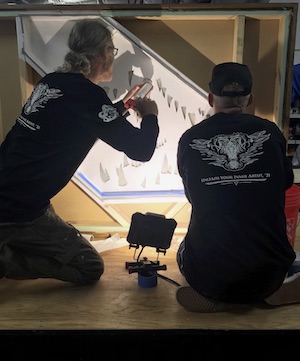

9 The backlighting for the teeth created some interesting challenges. It was a new approach given we had to work with a large frame and substrate, that required cutting out the area for every tooth. Cutting all the holes using another template and then setting them in place was quite the process.
10 This was a hybrid approach to presenting at a national show – remotely! Just the planning and organizing, the need for broadcasting technical help, the coordinating with the show staff and NTCA, took on a whole new level. Trying to be ready to go live and interactive at 7 different time slots over 2-1/2 days, and somehow be at the relevant place in the process to fit the agenda was quite the challenge.
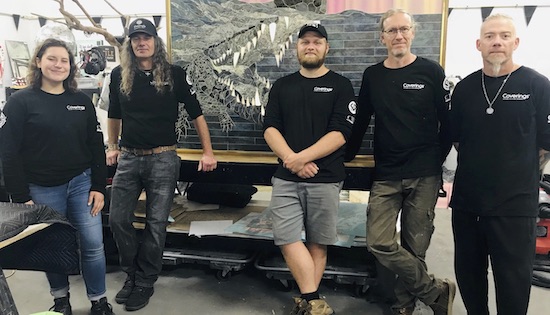

Nordstrom, Seth Ready, with Jane Callewaert behind the camera.
Seth Ready observed, “The fact Joshua and Lee coordinated most of this project from many miles apart from each other, and the fact they were able to time it down to the broadcast, and when it would get grouted is HUGE, in my opinion. It comes from the ability to communicate effectively (which is mainly listening). Each morning and each evening, a plan would be laid out, played out, picked apart and put back together, leaving little time for mistakes or miscommunication.”
The team continued, adding that artisan projects are, after all, art. Art doesn’t usually happen on a “schedule” and there were for sure some stressful moments just hoping the team could progress to the point they are expected to be at in the process.
That said, we had a blast and credit the entire team for making this happen. Having Seth volunteer to fly in and assist, and the support from Dragonfly staff, Maria Meyer and Shae Callewaert, was paramount to the success. Mark Heinlein worked onsite with us during a week in April when we started the whole process. This was extremely helpful, and his first-hand knowledge proved invaluable as he moderated the broadcast from Orlando. The technical assistance on-site, provided by TSE Live, was excellent and the coordination with the technical staff in Orlando was professional and flawless. We adopted our cameraman, Branion, as he was a critical part of the team effort and a real pro.
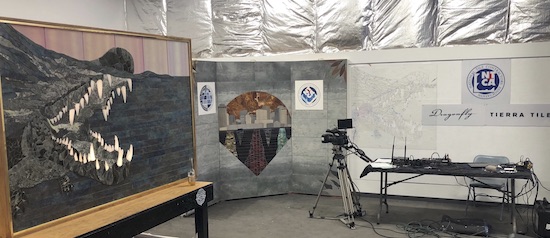

Editorial Director and Senior Writer for TileLetter and TileLetter ARTISAN
Lesley Goddin has been writing and journaling since her first diary at age 11. Her journey has taken her through a career in publishing and publicity, landing her the editor position of TileLetter and its special publications in 2006. Her goal is to educate, inspire, recognize and encourage those in the tile industry -- especially the tile and stone contractor.


